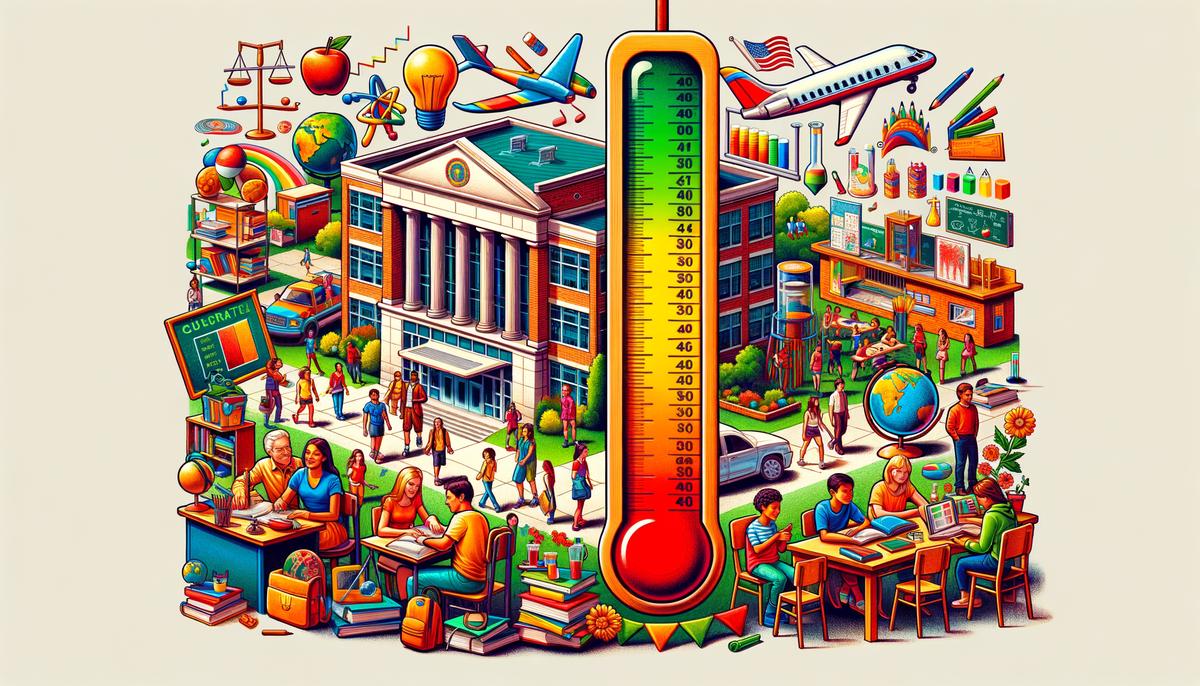The journey through the American education system is a structured pathway that guides students from the early days of primary education to the heights of higher academic achievement. This journey is marked by a series of transitions, each designed to build upon the last, preparing students for both professional success and personal growth. As we examine this educational landscape, we uncover the mechanisms and philosophies that shape these formative years, shedding light on how they contribute to the development of well-rounded individuals ready to face the challenges of tomorrow.
The Structure of the American Education System
American students begin their educational journey at age six by stepping into primary school, commonly known as elementary school. This period lasts about five to six years, laying the foundation for their future learning paths.
Next up is secondary school, divided into two key phases: middle school (or junior high school) and high school. Middle school serves as a bridge between elementary and high school, where students tackle more complex subjects. High school, culminating in graduation, challenges students to hone their skills and knowledge, preparing them for the next big leap.
Upon earning a high school diploma, the door to higher education swings open wide. Here, the landscape diversifies into colleges and universities where students aim for bachelors, masters, and even doctorate degrees. Colleges typically offer a broad spectrum of undergraduate degrees while universities dive deeper, facilitating both undergraduate and graduate studies.
The road through college is not just about majoring in a specific subject. The system encourages a broad-based education initially, advocating for students to taste different disciplines before specializing. This flexibility allows the pursuit of one’s passion, even if it means changing majors.
For students eyeing the academic summit, graduate programs offer paths to master’s degrees and beyond. Admission into these realms requires a blend of ambition, preparation, and sometimes, specialized tests like the GRE or LSAT.
Doctorate degrees represent the pinnacle of academic achievement. They demand years of dedication, advancing knowledge through original research that contributes meaningfully to their field of study.
Wrap all this in an inviting classroom environment designed for dynamic participation, debate, and discourse. From large lectures to intimate seminars, the focus is on nurturing opinions, ideas, and the courage to express them.
Credits play a pivotal role in this journey, quantifying students’ progress through their courses. A full load often constitutes 12 to 15 credits per term, translating to four or five classes that inch students closer to graduation.
For some, the educational journey introduces an additional chapter: transferring between institutions. Credits earned from one school can often pave the way to completing degrees at another, showcasing the system’s versatility.
From bustling state colleges and private universities to the more focused community colleges and technology institutes, the American education landscape offers a variety of settings tailored to diverse academic desires and career goals. Each steps play a crucial role in shaping a student’s future, emphasizing the system’s commitment to cultivating intellectual growth and professional success.

Grading System and Academic Achievement
Diving right into the core of how the U.S. grades its students, the grading system plays a pivotal role in reflecting a student’s academic performance. Using percentages that are converted into letter grades, the American grading scale typically follows a pattern from A to F, with A representing excellence and F indicating failure. This letter system is closely tied to a numerical range, where A equates to 90-100%, descending down to F which is usually below 60%.
A key component of this grading framework is the Grade Point Average (GPA), which is an averaged number demonstrating overall academic performance. Calculated on a scale of 0 to 4.0, GPAs are crucial for making informed decisions during college admissions. High GPAs often open doors to prestigious colleges, scholarships, and honor societies, showcasing a student’s dedication and understanding of their subjects.
However, the interpretation of grades can vary significantly between institutions. For instance, a B in one school might be considered quite different in terms of academic achievement at another school, owing to differences in curriculum rigor and grading standards. This discrepancy can present challenges for college admissions officers as they try to evaluate applicants on a common scale.
Furthermore, the American education system places great emphasis on continuous assessment. Apart from finals and midterms, students are evaluated on class participation, projects, presentations, and even attendance. This comprehensive evaluation method ensures that the grade a student receives encompasses their knowledge, practical skills, and engagement in the subject matter.
Interestingly, the grading system in the U.S. contrasts markedly with those in other countries, which may rely more heavily on final exams or standardized tests. American educators appreciate a more holistic view of student achievements, which includes both academic accomplishments and soft skills developed through classroom participation and group projects.
Another aspect worth noting is the role of AP (Advanced Placement) courses and honors classes, which can impact a student’s GPA by providing weighted scores. This means an A in an AP course could be calculated as a 5.0 instead of the standard 4.0, thereby offering students a way to elevate their GPA and stand out in competitive college admissions processes.
In conclusion, navigating the American grading system reveals much about the values embedded within the education sector: a blend of knowledge, skills application, and active learning participation. The varied absorption of this system by different schools empowers students with diverse learning experiences but also poses a unique set of challenges for equitable academic evaluation across the board.

Higher Education Levels
Navigating through the extensive landscape of U.S. higher education reveals more than just a pathway to academic and professional enhancement. It presents a labyrinth of opportunities, each unique in its approach to fostering expertise, critical thinking, and innovation. Engaging in professional studies in the U.S., for instance, opens doors to specialized fields like law, medicine, and dentistry, each requiring devoted years of study post-undergraduate education.
Professional studies typically follow the completion of an undergraduate degree, leading into rigorous programs such as Juris Doctor (JD) for law, Medical Doctor (MD) for medicine, and Doctor of Dental Surgery (DDS) for dentistry. These programs are not just about earning another academic title; they are an intense preparation for a specific career. Moving from theoretical knowledge to practical application, these programs often include internships, residencies, or clinical hours as a fundamental component of the curriculum.
For those drawn to the field of business, pursuing a Master of Business Administration (MBA) provides an exemplary illustration of how graduate-level education can amplify career prospects. Unlike more academically inclined master’s programs, an MBA emphasizes practical skills and networking, preparing students for leadership roles in various industries. It’s not uncommon for individuals with several years of professional experience to return to school for an MBA, aiming to catapult their careers to the next level with advanced management and strategic skills.
Beyond preparing for specific professions, higher education in the U.S. serves as a platform for in-depth research and scholarship. A noteworthy aspect is the potential for graduates to contribute to their field’s body of knowledge, especially at the doctoral level. PhD programs, for instance, are not just about attending courses but rather contributing original research that pushes the boundaries of their discipline. The aspiration is not solely to become an expert but to pioneer new discoveries and insights.
Considering varied academic calendars across institutions—semester, trimester, or quarter systems—the pace and intensity of study can greatly differ, affecting completion times and engagement. Flexibility in scheduling allows students to tailor their educational journey to match their individual goals and life circumstances.
Equally significant is the understanding that education extends beyond academics in the U.S. Participating in extracurricular activities, internships, and part-time jobs related to one’s field of study enriches the learning experience. These engagements offer practical experience, networking opportunities, and often, a clearer understanding of one’s career aspirations.
Moreover, the emphasis on soft skills like communication, teamwork, and problem-solving within American higher education underscores its holistic approach. Such skills are deemed vital across professions, enhancing employability and adaptability in a rapidly changing job market.
The landscape of higher education in the U.S. is vast and varied, featuring a patchwork of pathways tailor-made for different ambitions and careers. Whether through the rigorous training of professional studies or the scholarly pursuit of graduate degrees, the system is designed to equip individuals with the knowledge, skills, and experiences necessary to forge impactful careers and contributions to society.

Classroom Environment and Culture
In American schools, the dynamic relationship between educators and students plays a pivotal role in shaping the learning atmosphere. Teachers are not just imparters of knowledge; they act as facilitators for discussions, encouraging every student to voice their opinions and questions. This approach fosters an environment where debate and exchange of ideas are valued, aiding in the development of critical thinking skills. Students learn not only from textbooks but through the exchange of diverse viewpoints, preparing them for real-world challenges where solutions are not always black or white.
Participation is a cornerstone of the classroom experience, with students often graded on how actively they contribute to discussions. This system pushes students out of their comfort zones and into active engagement with the material. It’s not uncommon for a class session to deviate from lecture notes to accommodate a lively discussion sparked by a student’s question or comment. These spontaneous debates can lead to deeper understanding of the subject matter, as well as develop students’ ability to articulate and defend their positions.
Technology integration further enhances learning in American schools. Smartboards, laptops, and educational software have become commonplace, allowing for an interactive learning experience. Videos, simulations, and online forums complement traditional teaching methods and cater to different learning styles. This blend of technology and teaching not only keeps students engaged but also equips them with digital literacy skills critical in today’s technology-driven world.
Teachers often employ a variety of resources to accommodate different learning preferences, such as group projects, individual research assignments, and hands-on activities. This variety ensures that learning is accessible to all students, regardless of their preferred learning method. Group projects emphasize teamwork and communication skills, preparing students for workplace environments where collaboration is key. Individual assignments, on the other hand, foster independence and personal accountability.
American schools also emphasize the practical application of knowledge. It’s not uncommon for students to engage in experiments, field trips, and project-based learning initiatives that bring textbook theories to life. These experiences are invaluable, bridging the gap between theoretical knowledge and real-world application. Students learn to appreciate the relevance of their studies, seeing firsthand how their lessons have direct implications outside the classroom walls.
In fostering a classroom environment where participation, technology, diverse teaching methods, and practical application are in focus, American schools cultivate not just academic proficiency but well-rounded individuals. Skills like critical thinking, public speaking, collaboration, and digital literacy are emphasized, aligning education with the demands of the modern workforce. This holistic approach to learning ensures that students are not just academically prepared but also ready to tackle the complexities of the evolving global landscape.

Types of U.S. Higher Education Institutions
State colleges and universities, known as public universities, are funded by state governments. This funding helps keep tuition costs lower for in-state students, a big advantage for residents of that state. Each of the 50 U.S. states has at least one state university. Public universities often have a large student body and offer a wide range of majors and programs. They’re famous for their extensive research facilities and diverse academic options.
Private colleges and universities operate without state government funding, relying instead on tuition, donations, and endowment funds. This can mean higher tuition rates for students. However, private institutions often offer generous financial aid packages. They can vary in size from small colleges to large universities and tend to have smaller class sizes, allowing for more personalized attention from faculty. Many private colleges emphasize liberal arts education but also offer programs in a variety of fields.
Community colleges offer a more affordable entry point into higher education, with lower tuition costs than four-year institutions. They primarily award associate degrees and certifications, with programs designed to prepare students for immediate employment or transfer to four-year universities. Community colleges serve local communities, offering a flexible option for part-time, working, or returning students. The smaller classes foster a supportive environment, making it easier for individual attention.
Institutes of technology specialize in engineering, science, and technology programs, though many also offer courses in other fields. These institutions tend to be at the forefront of innovation and research, providing students with hands-on learning opportunities through labs and industry partnerships. Institutes of technology can either be part of a state-funded university or an independent private institution. Their programs are rigorous, designed to prepare students for high-demand careers in technical fields.
Each type of institution caters to different student needs and career goals. Understanding the distinct characteristics of state colleges, private universities, community colleges, and institutes of technology helps students make informed decisions about their educational paths. Whether a student is looking for a broad liberal arts education, a specialized technology program, a cost-effective two-year degree, or an immersive research university experience, the U.S. higher education landscape has options to explore. This diversity ensures that students can find the right fit for their ambitions, learning style, and financial situation, setting the stage for their future success.

In conclusion, the American education system is a comprehensive framework aimed at fostering intellectual growth, practical skills, and critical thinking. The most crucial aspect of this journey is its commitment to creating environments that encourage dynamic participation and the exchange of ideas. This approach not only prepares students academically but also equips them with the essential skills needed to navigate future challenges successfully. By understanding the structure and purpose behind each educational stage, students are better positioned to leverage their experiences for long-term success.
Writio: AI writer for websites & blogs. Content crafted by Writio.
Leave a Reply